The most expensive helmets. Part Five Benti Grange Helmet
Of course, for a layman, the Benti Grange helmet is not a very impressive thing. A lot of rust and a little gold and silver. But it is valuable for its uniqueness, and its image is included in all historical monographs on military affairs and armor of Britain.
And now, before going further, I would like to be a little devoted to memories that are directly related to this helmet. I remember well how in childhood, after watching historical films with warriors in armor and helmets, I also wanted to make myself a helmet. It is clear that I could only make it out of paper. But how, because it does not stretch and curved surfaces can not be made of it. However, the very nature of the material suggested to me a solution: on a wide rim around my head I cross-glued four strips of thick paper and pasted triangles between them. This is how the helmet turned out, in its design very similar to the “Benti Grange helmet”, moreover, I for some reason stuck a plastic horse figure to its top. That is, it can be said that if this technical solution occurred to the 6-7 boy of years, then it should have come to adults even unhappy. And this is how this type of helmet appeared. And it was simple, cheap, convenient and ... reliable.
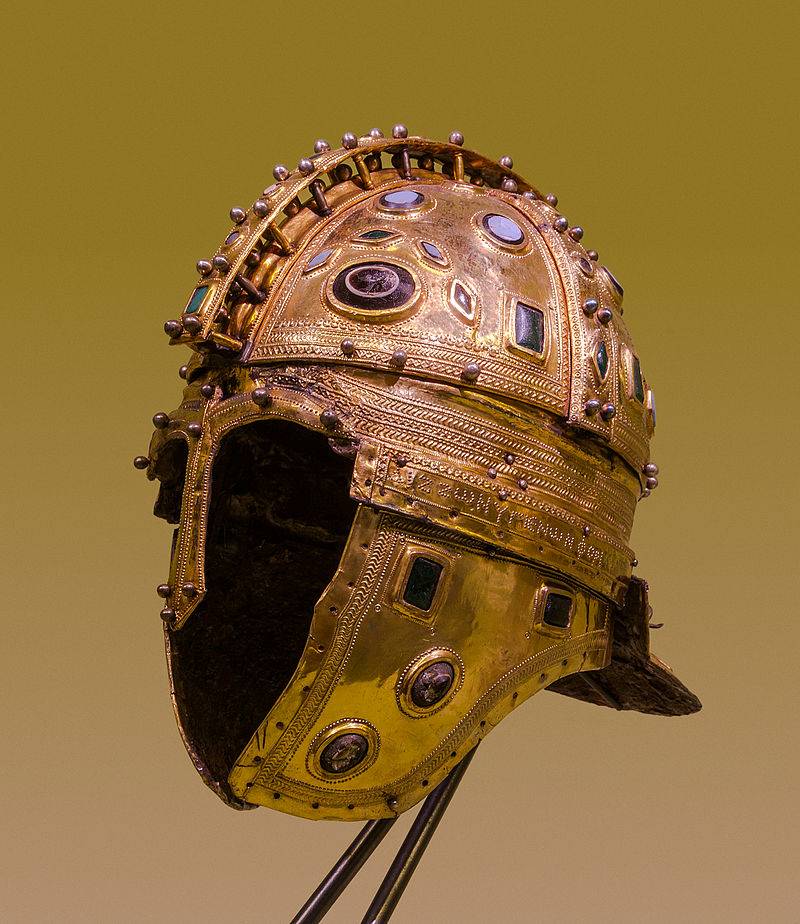
The Romans, of course, made the helmets much more spectacular. But from their culture in England remained mainly bridges and roads. Helmet from the “Berkasov Treasures” Vojvodina Museum, Novy Sad, Serbia.
The helmet had an iron frame inside which were installed horny plates. Inside it was covered with cloth or leather, but these materials, naturally, were not preserved in the earth. Many believe that protection from weapons if such a design provided, it was not very reliable. Therefore, they say, this helmet was richly decorated and, perhaps, had a ceremonial purpose. It is one of six famous Anglo-Saxon helmets found in Sutton Hoo, York, Wollaston, Shorvelle and Staffordshire. The combination of its structural and technical details is unique, but similar helmets are known. It is believed that such helmets were used in northern Europe from the sixth to the eleventh centuries of our era.
"Helmet of Derne", the beginning of the IV century AD (National Museum of Antiquities, Leiden)
The most catchy detail of this helmet is the boar on its top. But in this case cultural syncretism takes place; This clearly pagan symbol complements the Christian cross on the nose.
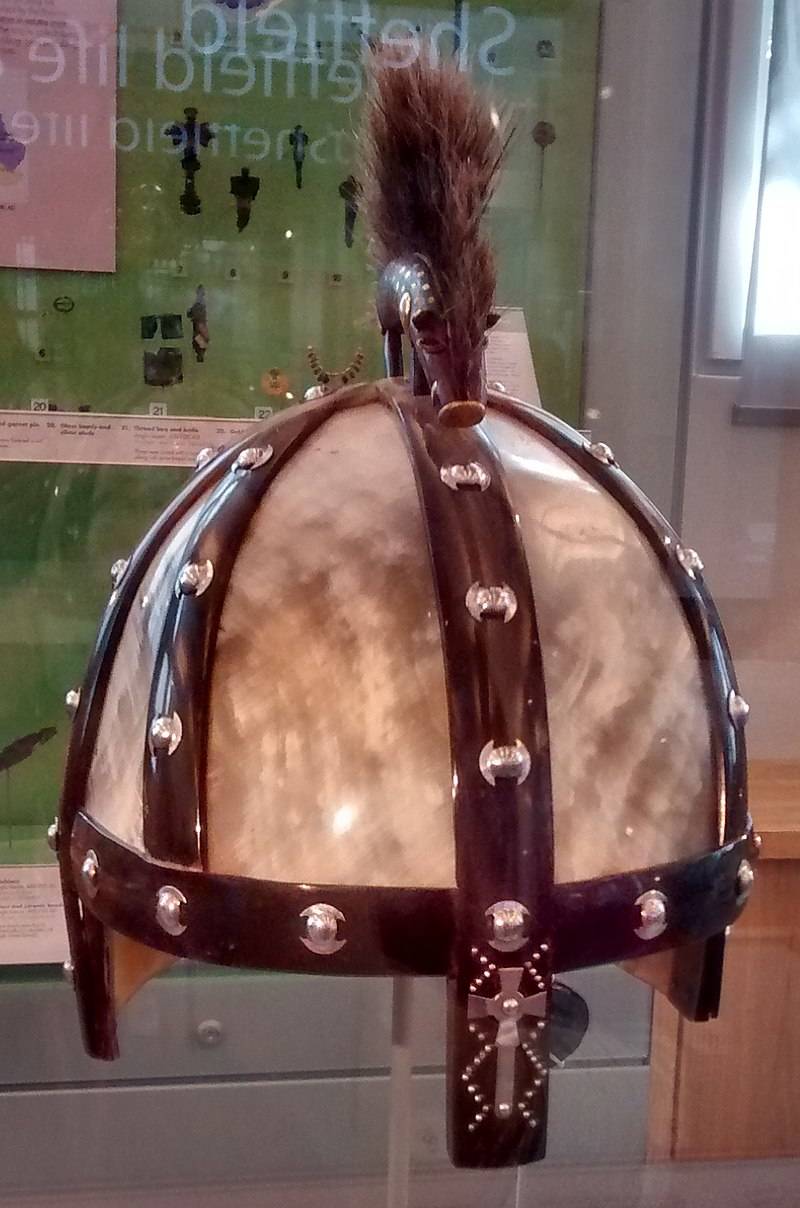
A replica of Benty Grange slam at the Weston Park Museum in Sheffield. Does not it look very original, and besides, he is just beautiful.
The base of the helmet consists of sixteen damaged fragments, and initially consisted of seven iron bands, each from 1 to 2 millimeters thick. The basis was the 65 strip cm long and 2,5 cm wide around the head. Two bands of the same width passed in front and behind: 40 cm. The length of the band from the nose to the back of the head, 4,75 cm in width in the front and 3,8 cm in the back. The four squares created by these strips were divided in turn by a narrow auxiliary stripe. Each auxiliary strip was attached to the outside of the main strip. Here, these bands had a width of 22 mm, tapering to 15 mm towards the crown. There they overlapped at an angle 50 ° under the figure fixed there. The inner part of the helmet, most likely, was originally lined with leather or cloth.
The “empty spaces” between the iron plates were covered with eight horn plates, probably curved in shape, which were cut to fit the space created by the iron base. Now there is no horn, but its mineralized remains are preserved on the iron bands. The inserts consisted of three layers of horny plates; internal, one-to-one-fit, and then two layers of horns, filling the spaces between the metal strips. All three layers were fastened with rivets: iron rivets placed inside the helmet fastened the horn and metal bands, while rivets made of silver or silver coated with ornamental heads in the shape of a double-headed ax were placed outside, at a distance of 4 cm and joined plates in one "package".
The helmet had decorations; a cross on the bow and a figurine of a wild boar made of iron on the crown. The silver cross is 3,9 cm high and 2 cm wide and consists of two parts. Around the cross in a zigzag pattern there are twenty-nine silver studs from the original forty, which were probably inserted into small holes. But the most distinctive feature of this helmet is the boar attached to its top. Holes were made in the body of the boar, probably punched, which held round silver studs with a diameter of approximately 1,5 mm. The studs, probably made flush with the surface of the body, were gold-plated and, possibly, designed for fastening gold bristles. The eyes were made of oval garnets 5 mm long, installed in gold rosettes with filigree wire pruning. The sockets had a length of 8 mm, a width of 3,5 mm and had a long shank length 8 mm, filled with beeswax. The figure was supposed to be attached to an elliptical plate with a length of 9 cm, and a maximum width of 1,9 cm, corresponding to the curvature of the helmet. The four holes on it indicate the attachment points for the legs, and three more are connected to the holes on the plate on the helmet frame, in addition to the large rivet hole slightly behind the center. So the figure was fixed on the helmet very carefully. It is clear that corrosion to a large degree of this boar "ate", but it is undoubted that it is a boar!
Now let's see what Benti Grange mound itself was. It was a mound with a diameter of about 15 m and a height of 6 m, which was surrounded by a moat about 1 m wide and 0,3 m deep, and a few dimples about 3 m and 0,2 m. Other objects commonly found in graves with a helmet, there is a sword and shield that were missing, which suggests that the grave had already been ransacked before. They also found a cup, identified as made of leather, but probably a wooden one with a diameter of about 7,6 cm, the rim of which was edged with silver and decorated with four wheel-shaped ornaments and two crosses made of fine silver, attached with pins of the same metal. There were other finds, but under the action of air, they crumbled into dust. That is, it was a burial, and not a random treasure. That's just who exactly was buried in it, we, of course, now never know.
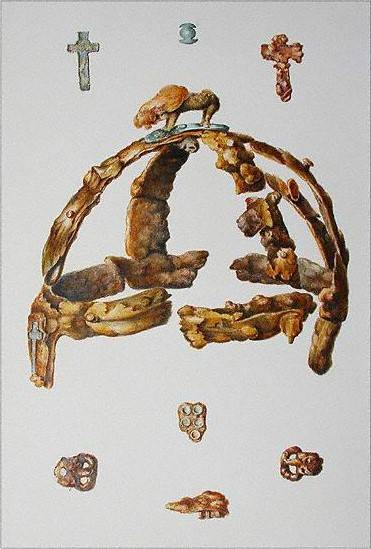
Watercolor from Lewellin Levitt 1886 G. depicting the details of Benti Grange helmet.
The helmet was first shown at the Weston Park Museum in 1893, and in 1948, it was taken to the British Museum for study. It was possible to find out that the boar figure was not integral, but consisted of two halves. The sophisticated design of the boar Benty Grange is amazing because it combines the use of garnets, filigree, gold, silver, iron and bronze and is unique to Anglo-Saxon helmets, because the easiest thing would be to cast such a bronze figure! But for some reason, the ancient masters chose such an extremely complex technology. At first, they forged the two halves of the boar figure, moreover the hollow inside. Then they punched holes in them for fixing on the figure ... bristles, inserted eyes, filled the figure itself with wax and fixed it through the holes for the legs, first on the plate, and only then this plate was fixed on the helmet. The impression is that to think about how to ease the work, they clearly did not want that the boar, in their opinion, could only be iron, but not bronze. And why this is all so - it is still unclear! It is not known, by the way, and how much it can cost, since no one has ever tried to sell or buy it.
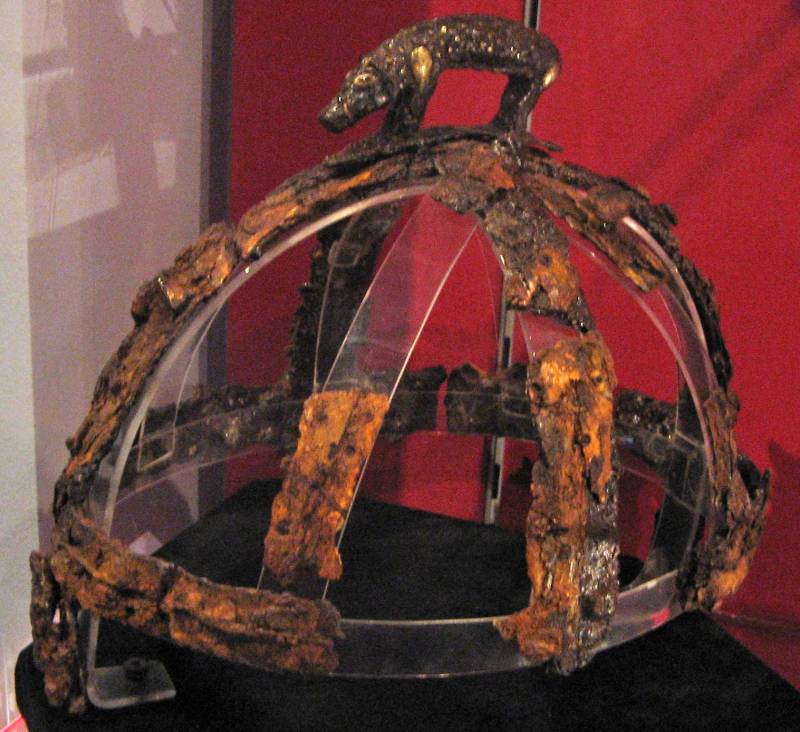
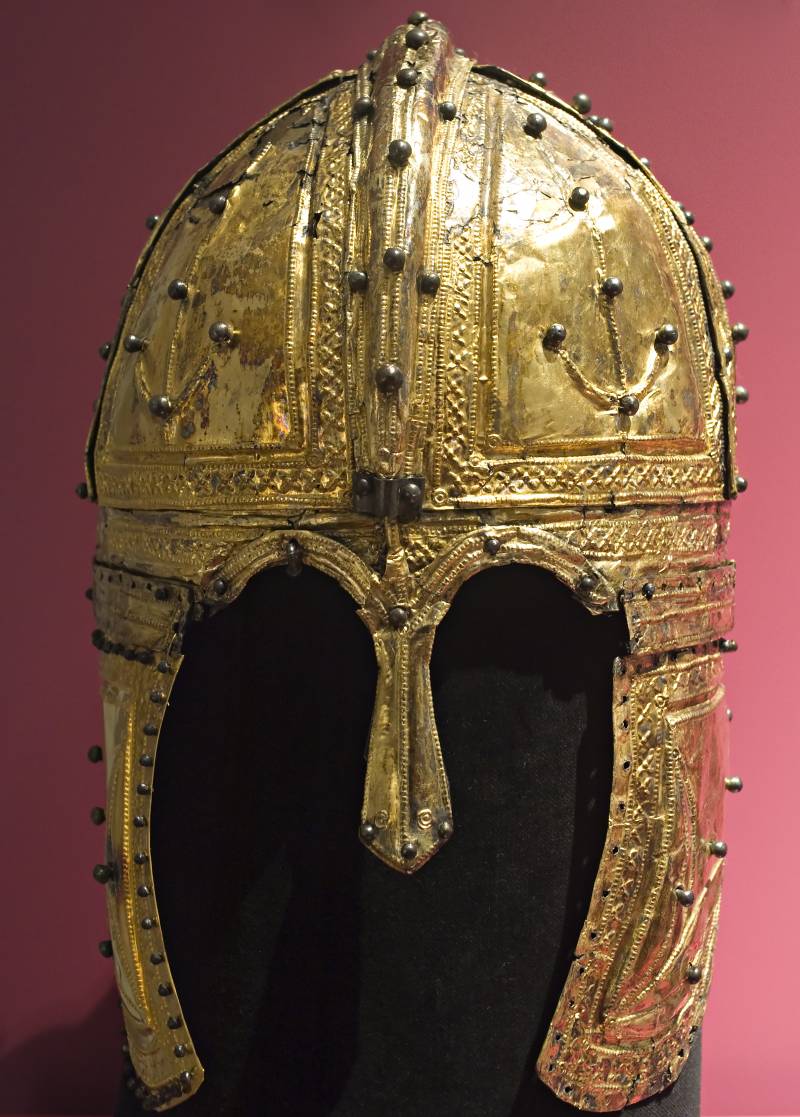
Information